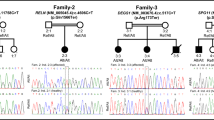Abstract
Wilson’s disease (WD) is an autosomal recessive disease caused by an excessive accumulation of copper. The molecular genetic etiology of the disease is due to impairment of the ATP7B gene encoding copper-transporting ATPase. The spectrum and frequencies of mutations in the ATP7B gene are reported in the present study. The analysis was performed via allele-specific ligation for the search for frequent mutations, via massive parallel sequencing for the search for rare nucleotide substitutions, and via Multiplex Ligation-dependent Probe Amplification (MLPA) for the analysis of the copy number of all exons in the ATP7B gene. This study summarizes the findings from 431 DNA samples of patients with a preliminary diagnosis of Wilson’s disease analyzed for pathogenic ATP7B variants. DNA samples of 1000 unexamined individuals from different regions of the Russian Federation were used to estimate population frequencies. The spectrum of mutations in the ATP7B gene was determined in patients from Russia. A total of 66 different variants of the nucleotide sequence in the ATP7B gene were revealed, including 42 previously described pathogenic variants and 24 primarily identified ones. The most frequent pathogenic ATP7B variant in the Russian population of patients with Wilson’s disease was missense mutation c.3207C>A present in 50% of mutant alleles. Pathogenic variants c.2403insC, c.3204delC, c.3036insC, and c.3190G>A were also found to be more prevalent. The expected number of patients with Wilson’s disease in the studied sample was 208 of 431 individuals. The cause of the disease was established in 78% of patients with hepatolenticular degeneration. The carrier frequency of Wilson’s disease was found to be 1 per 50 individuals from Russia (confidence interval from 1 : 42 to 1 : 63). The calculated frequency of the disease is 1 per 10 000 individuals from Russia (confidence interval from 1 : 8333 to 1 : 12 500).

Similar content being viewed by others
REFERENCES
Schilsky, M.L., Wilson disease: genetic basis of copper toxicity and natural history, Semin. Liver Dis., 1996, no. 16, pp. 83—95. https://doi.org/10.1055/s-2007-1007221
Gollan, J.L. and Gollan, T.J., Wilson disease in 1998: genetic, diagnostic and therapeutic aspects, J. Hepatol., 1998, suppl. 1, pp. 28—36.
Tanzi, R.E., Petrukhin, K., Chernov, I., et al., The Wilson disease gene is a copper transporting ATPase with homology to the Menkes disease gene, Nat. Genet., 1993, no. 5, pp. 344—350. https://doi.org/10.1038/ng1293-344
Ferenci, P., Regional distribution of mutations of the ATP7B gene in patients with Wilson disease: impact on genetic testing, Hum. Genet., 2006, no. 120, pp. 151—159. https://doi.org/10.1007/s00439-006-0202-5
Behari, M. and Pardasani, V., Genetics of Wilsons disease, Parkinsonism Relat. Disord., 2010, no. 16, pp. 639—644. https://doi.org/10.1016/j.parkreldis.2010.07.007
Deguti, M.M., Genschel, J., Cancado, E.L., et al., Wilson disease: novel mutation in the ATP7B gene and clinical correlation in Brazilian patients, Hum. Mutat., 2004, no. 23(4), p. 398. https://doi.org/10.1002/humu.9227
Firneisz, G., Lakatos, P.L., Szalay, F., et al., Common mutations of ATP7B in Wilson disease patients from Hungary, Am. J. Med. Genet., 2002, no. 108(1), pp. 23—28.
Figus, A., Angius, A., Loudianos, G., et al., Molecular pathology and haplotype analysis of Wilson disease in Mediterranean population, Am. J. Hum. Genet., 1995, no. 57, pp. 1318—1324.
Bayazutdinova, G.M., Shchagina, O.A., and Polyakov, A.V., c.3207C>A mutation in the ATP7B gene is the most common cause of hepatolenticular degeneration in Russia: frequency and the cause of spread, Med. Genet., 2018, no. 4, pp. 25—30.
Ryzhkova, O.P., Kardymon, O.L., Prokhorchuk, E.B., et al., Guidelines for the interpretation of massive parallel sequencing variants, Med. Genet., 2017, no. 7, pp. 4—17.
Gomes, A. and Dedoussis, G.V., Geographic distribution of ATP7B mutations in Wilson disease, Ann. Hum. Biol., 2016, no. 43(1), pp. 1—8. https://doi.org/10.3109/03014460.2015.1051492
Chang, I.J. and Hahn, S.H., The genetics of Wilson disease, Handb. Clin. Neurol., 2017, no. 142, pp. 19—34.
Poujois, A. and Woimant, F., Wilson’s disease: a 2017 update, Clin. Res. Hepatol. Gastroenterol., 2018, no. 42(6), pp. 512—520. https://doi.org/10.1016/j.clinre.2018.03.007
Asanov, A.Yu., Sokolov, A.A., Volgina, S.Ya., et al., Federal’nye klinicheskie rekomendatsii po diagnostike i lecheniyu bolezni Vil’sona—Konovalova (Federal Clinical Guidelines for the Diagnosis and Treatment of Wilson Disease), Moscow, 2015.
Sokolov, A.A., Dembrovskii, V.N., and Krasil’nikova, E.Yu., Provision of medical care and pharmaceutical supplies for patients with life-threatening and chronic progressive rare diseases: Wilson disease (hepatolenticular degeneration), Probl. Stand. Zdravokhr., 2015, nos. 5—6, pp. 30—36.
Funding
The present study was supported within the framework of a state contract of the Federal Agency for Scientific Organizations of Russia.
Author information
Authors and Affiliations
Corresponding author
Ethics declarations
Conflicts of interest. The authors declare no conflict of interest.
Statement of compliance with standards of research involving humans as subjects. All procedures performed in studies involving human participants were in accordance with the ethical standards of the institutional and/or national research committee and with the 1964 Helsinki Declaration and its later amendments or comparable ethical standards. Informed consent was obtained from all individual participants involved in the study.
Additional information
Translated by A. Kazantseva
Rights and permissions
About this article
Cite this article
Bayazutdinova, G.M., Shchagina, O.A., Karunas, A.S. et al. Spectrum of Mutations in the ATP7B Gene in Russian Patients with Wilson’s Disease. Russ J Genet 55, 1528–1535 (2019). https://doi.org/10.1134/S1022795419120020
Received:
Revised:
Accepted:
Published:
Issue Date:
DOI: https://doi.org/10.1134/S1022795419120020




